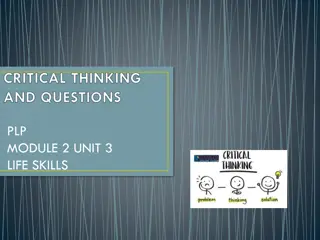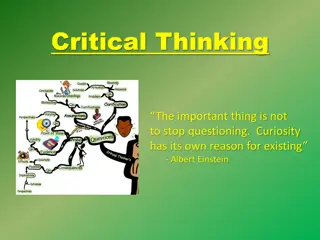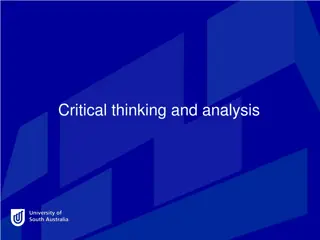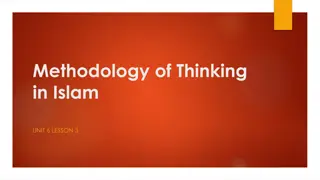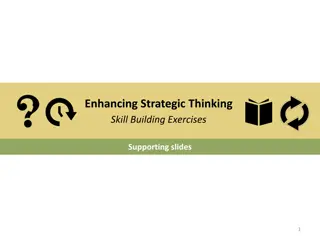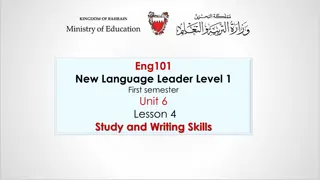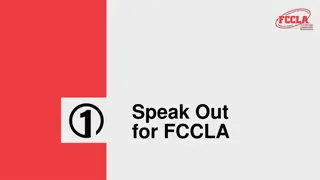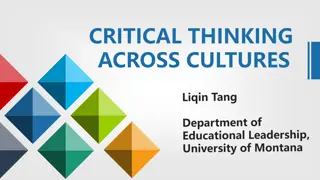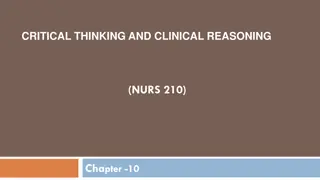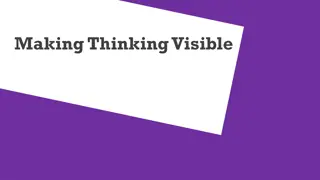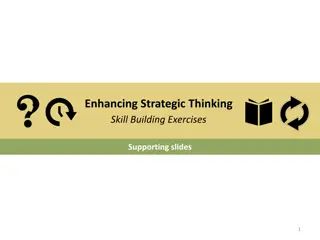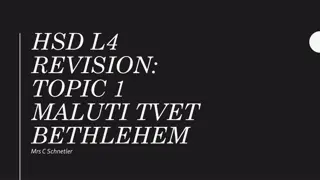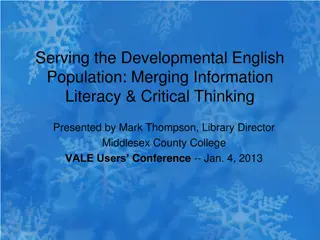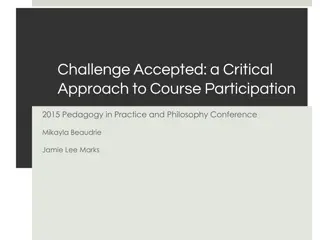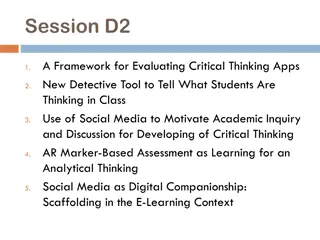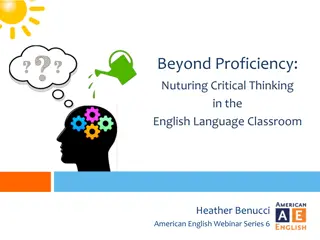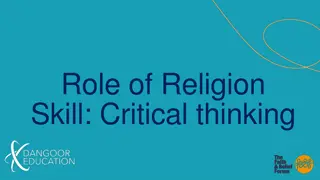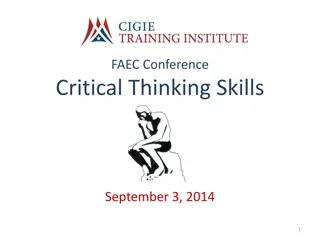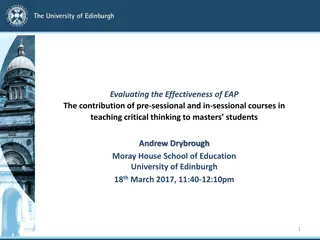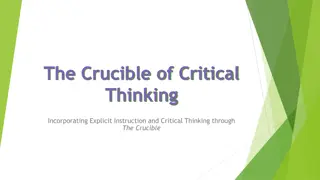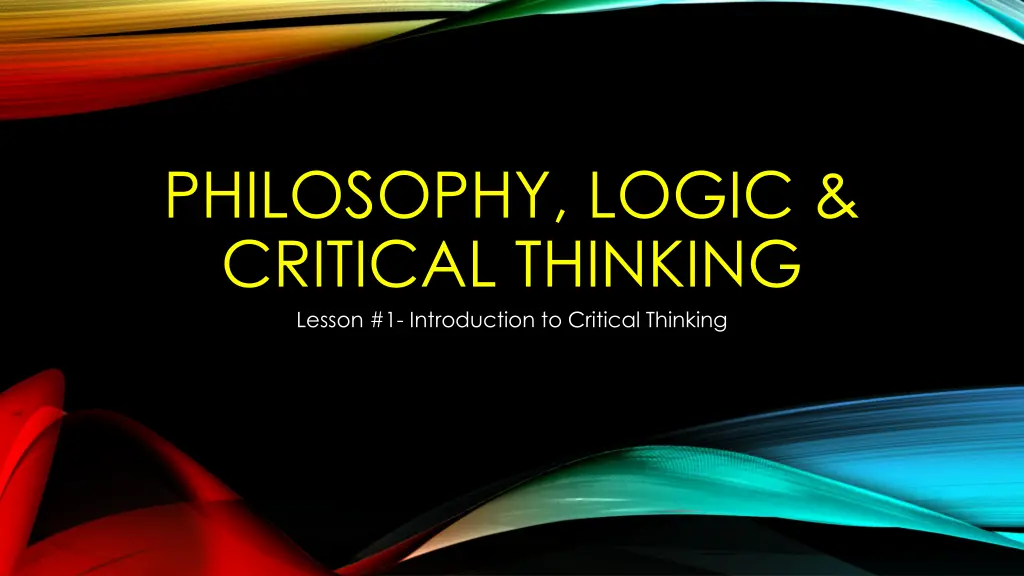
Critical Thinking in Philosophy & Logic
Explore the foundations of critical thinking in philosophy and logic with a focus on evaluating beliefs and statements using rational standards. Gain insights into key definitions and learn systematic methods to assess arguments effectively.
Download Presentation

Please find below an Image/Link to download the presentation.
The content on the website is provided AS IS for your information and personal use only. It may not be sold, licensed, or shared on other websites without obtaining consent from the author. If you encounter any issues during the download, it is possible that the publisher has removed the file from their server.
You are allowed to download the files provided on this website for personal or commercial use, subject to the condition that they are used lawfully. All files are the property of their respective owners.
The content on the website is provided AS IS for your information and personal use only. It may not be sold, licensed, or shared on other websites without obtaining consent from the author.
E N D
Presentation Transcript
PHILOSOPHY, LOGIC & CRITICAL THINKING Lesson #1- Introduction to Critical Thinking
COURSE OVERVIEW This course is adapted based on my teaching of SSH105 at Ryerson University. SSH 105 is a required course for students in several first-year undergraduate level Arts programs. The calendar description of the course is as follows; Rational discourse has long been viewed as a principal force for social change. In this course, we will examine the structures and principles that undergird all forms of rational discourse, and we will learn how to assess the logical strength and persuasiveness of particular discourses. These skills will be applied to arguments found in everyday life, and to the formulation of one s own positions .
COURSE OVERVIEW The course will be made up of 4 Main Units (with multiple class lessons each); Unit #1- Introduction to Critical Thinking Unit #2- Characteristics and Classification of Arguments Unit#3- Argument Reconstruction Unit #4- Evaluating Arguments The two main texts used for this course are; Richard Feldman s Reason and Argument (second edition). Chris MacDonald and Lewis Vaughn, The Power of Critical Thinking, 5th Canadian Edition, New York: Oxford University Press, 2019
WHAT IS CRITICAL THINKING? Critical thinking is the systematic evaluation or formulation of beliefs, or statements, by or in accordance with rational standards. It s systematic because it involves distinct procedures and methods (not just gut feelings) used in accordance with the rules of logic. It s used to both evaluate our existing beliefs and arguments and to formulate new ones. It evaluates beliefs in terms of how well they are supported by reasons (evidence).
SOME KEY DEFINITIONS Statement (i.e., Assertion/Claim): A statement or assertion is expressed by a declarative sentence that is intended to make a claim of some sort. (E.g. Today is Friday , I am shorter than you , It is snowing in Toronto right now. ). Propositions: refer to the specific thought or idea which the statement is meant to express, convey or represent. It is possible for two different statements to represent the same proposition. E.g. My name is Dale and Je m'appelle Dale represent the same proposition, but in different words as per two different languages (English and French respectively). Likewise, it is possible for the same statement to express different propositions (depending on the context of the who, when and where). E.g. I am hungry , It will snow tomorrow , It s depressing to be here . Statements and propositions are both factual in nature, meaning they can be either true or false.
STATEMENTS VS. SENTENCES Not all sentences are statements, some represent mere questions, exclamations or commands where it doesn t make sense to think of such as being either true or false. Which of the following are statements vs. sentences? A) Should I go to class today? B) Nachos! C) Eating at that new breakfast place was a terrible mistake. D) Shut up and go take a nap now.
SOME KEY DEFINITIONS CONT. Remember, critical thinking is said to be systematic because it involves distinct procedures and methods used in accordance with the rules of logic. This usually involves presenting arguments. Arguments are a set of statements in which one or more statements (the premises) are intended to support another (the conclusion). Premises are statements offered as presumed rational reasons or evidence in support of accepting/believing the conclusion. Conclusions are statements that the speaker/writer wants you to accept/believe, which is held to be supported by the premises. Premise: All whales are mammals. Premise: Moby Dick is a whale. Conclusion: Moby Dick is a mammal. _____________________ An inference is the logical move from a premise (or premises) to a conclusion (or conclusions). Critical thinking is all about logical inferences and there are many different kinds of inferences (such as the common patterns of reasoning illustrated by the various deductive argument patterns that we will learn more about later). Some logical inferences are good and some are bad.
ARGUMENTS OR NOT? Not all sets of statements represent logical arguments. The following represent some types of statements that do not constitute a proper argument . 1. Descriptions- don t confuse arguments with mere descriptive texts (a mere narrative description of an event or thing). 2. Statements of Mere Opinion/Belief- some texts merely present the author s opinions without trying to provide any reasons (or at least any logical reasons) to accept it. 3. Conditionals- mere conditionals ( If-Then statements) by themselves provide no reasoning or argumentation. 4. Explanations- don t confuse arguments with explanations. An explanation tells you why something happened whereas an argument tells you why you should believe something; arguments have something to prove, explanations do not! E.g. Adam stole the money, for three people saw him do it OR Adam stole the money because he needed to buy food.
3 SYSTEMATIC STEPS REGARDING ARGUMENTS 1. Determine if there is an argument being made or not. 2. Reconstruct the argument. 3. Evaluate the argument. This simple 3-step process involves a lot of work and we will primarily be focusing on Steps #2 & 3 as we go forward in this course.
WHY SHOULD WE THINK CRITICALLY? 1. Because there is a strong correlation between belief and truth in that we seem to want to believe things that are true rather than false. When we discover something we believe is in fact false, we tend to lose our belief in it (E.g. Santa Claus, tooth fairy, etc.) 2. Because who we are is in large part determined by our actions and choices and our actions and choices are in turn largely determined by our thoughts and beliefs. If we don t choose our beliefs carefully, we re giving up control. Critical thinking empowers us to have more personal freedom in the beliefs that we hold to be true (not just passively accepting beliefs given too us by our parents, teachers or culture, etc.). 3. Provides us with the means to fulfill and attain our passions and desires through better knowledge and understanding (means to ends reasoning for example). 4. Provides us the means to think outside the box and cultivates human creativity and innovation. 5. Gives us the means to attain knowledge.
OBJECTIONS TO CRITICAL THINKING They claim we should avoid thinking critically because it leads many people to be excessively critical cynical emotionally cold creatively constrained Unfortunately, this is true for about a lot of people today, but critical thinking in itself is just a set of skills that need not be used in these bad ways. It is on the critical thinker, as a person, to ensure they use their critical skills responsibly and in an proper ethical manner. As to supposed creativity constraint, nothing could be further from the truth! Critical thinking is all ABOUT thinking outside the box as it frees our minds from the shackles of our own limitations and forces us to: challenge our assumptions. ask hard questions. reject our biases, stereotypes, and other unreasonable assumptions.
PART 2 INTRODUCTION PART 1 RECAP .. LEFT OFF WITH GAINING KNOWLEDGE AS A BENEFIT FOR WHY WE WANT TO CRTICIALLY THINK.
WHAT IS KNOWLEDGE? Hi LEFT OFF HERE!!! Lecture 1 & 2 for Klaas and Andrew Hunter Explain different theories with helpful diagram tree chart or box chart perhaps.
IMPEDIMENTS TO CRITICAL THINKING Recall our first definition: Critical thinking is the systematic evaluation or formulation of beliefs or statements by rational standards. 2 common categories of impediments to critical thinking: Category 1: Hindrances that arise because of how we think. Category 2: Hindrances that occur because of what we think. Hi Andrew Hunter Fall 2020- slides in TA Folder Lecture 2 = LEFT OFF HERE!

